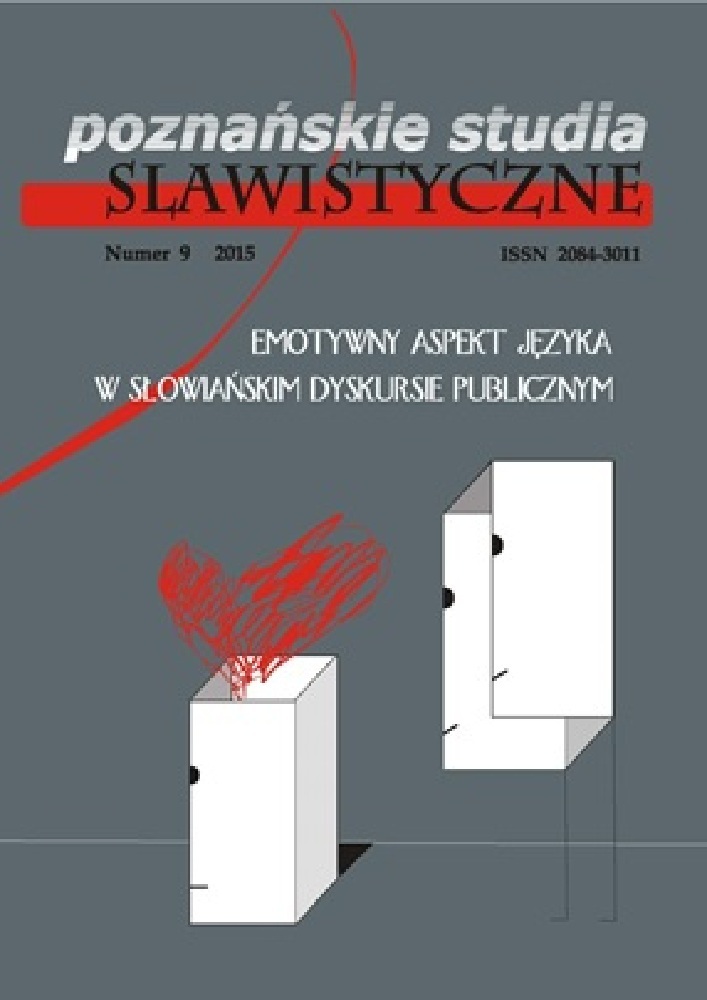Abstract
This article presents an emergent model of the conceptualization of strah (Fear) in Croatian with focus on the constructions derived from the container image schema coded by preposition u (in). the semantic and syntactic analysis of the collocations of lexeme strah demonstrates conceptual hierarchy of the activation of metonymic and metaphoric processes via syntactic organization and perspectivization. It is argued that the meaning of the lexeme strah is conceptualized by metonymic profiling sensory-motor correlates of affective states and by superimposing metaphorical mappings of objects, spatial relations, object/entities with thematic and agentive roles that are organized in an emergent system of respective ontological, spatial, thematic and agentive patterns of linguistic constructions.
References
Anderson J.M., 1971, The Grammar of Case. Towards a Localistic Theory, Cambridge.
Barsalou L.W., 2008, Grounded cognition, „Annual Review of Psychology” br. 59, str. 617–645.
Belaj B., 2008, Jezik, prostor i konceptualizacija. Shematična značenja hrvatskih glagolskih prefiksa, Osijek.
Belaj B., 2009, Prostorna značenja na razini složene rečenice, Osijek.
Kerovac B., 2012, Kognitivnolingvistička analiza prostornih odnosa u turskom i hrvatskom jeziku, doktorska disertacija, Zagreb.
Kövecses Z., 1990, Emotion concepts, New York. http://dx.doi.org/10.1007/978-1-4612-3312-1
Kövecses Z., 2000, Metaphor and Emotion. Language, Culture, and Body in human feeling, New York.
Kövecses Z., 2002, Metaphor. A Practical Introduction, New York.
Lakoff G., Johnson M., 1980, Metaphors We Live By, Chicago.
Lakoff G., 1987, Women, fire, and dangerous things. What categories reveal about the mind, Chicago. http://dx.doi.org/10.7208/chicago/9780226471013.001.0001
Langacker R., 2008, Cognitive Grammar. An Introduction, New York.
http://dx.doi.org/10.1093/acprof:oso/9780195331967.001.0001
Matovac D., 2013, Semantika hrvatskih prijedloga, doktorska disertacija, Osijek.
Oster U., 2012, „Angst” and „Fear” In Contrast. A Corpus-Based Analysis Of Emotion Concepts, u: Cognitive Linguistics between Universality and Variation, ur. M. Brdar, I. Raffaelli, M. Žic Fuchs, Frankfurt a/M–Berlin–Bern–Bruxelles–New York–Oxford–Vienna.
Perak B., 2014, Opojmljivanje leksema strah u hrvatskome: sintaktičko-semantička analiza, doktorska disertacija, Zagreb.
Perak B., Puljar DʼAlessio S., 2013, Kultura kao emergentno svojstvo otjelovljene spoznaje, u: Avanture kulture. Kulturalni studiji u lokalnom kontekstu, ur. N. Fanuko, S. Puljar DʼAlessio, Zagreb.
Pineda J. (ur.), 2009, Mirror Neuron Systems. The Role of Mirroring Processes in Social Cognition, New York.
Pranjković I., 1992, Prostorna značenja prijedloga u hrvatskome standardnom jeziku, „Suvremena lingvistika” br. 33, str. 21–26.
Rizzolatti G., Sinigaglia C., 2008, Mirrors in the Brain. How We Share our Actions and Emotions, New York.
Silić J., Pranjković I., 2005, Gramatika hrvatskoga jezika za gimnazije i visoka učilišta, Zagreb.
Šarić Lj., 2008, Spatial Concepts in Slavic, A Cognitive Linguistic Study of Prepositions An Cases, Weisbaden.
Talmy L., 2000, Toward a Cognitive Semantics, Cambridge.
License

This work is licensed under a Creative Commons Attribution-NoDerivatives 4.0 International License.
